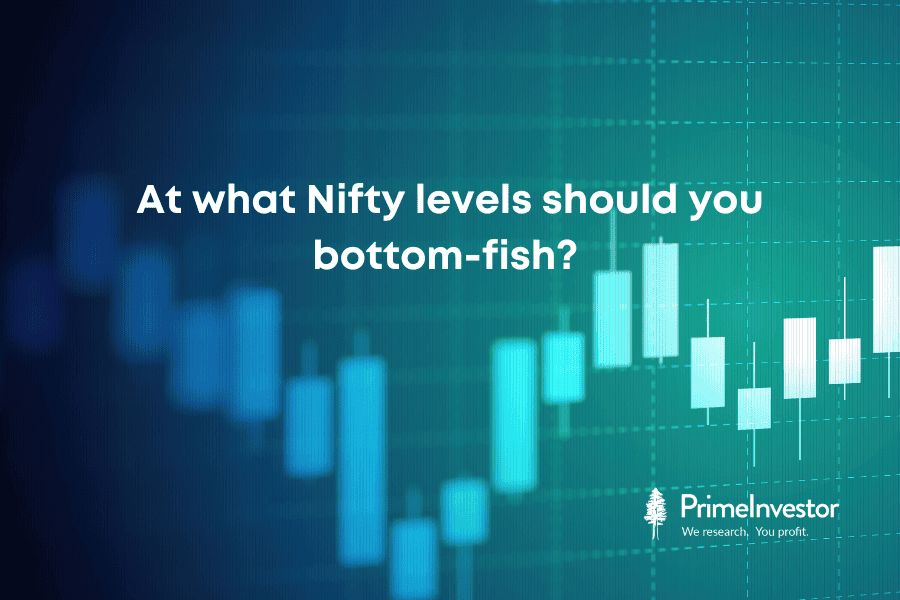As Lok Sabha elections wind on, the stock markets have been getting restless about the outcome. They have moved from extreme complacency about ‘400 paar’ to extreme doubt about whether the NDA will even return. But irrespective of the predictions going around, it would be safe to assume that no one knows anything about the results, until the tally is out on June 4.
Rather than try to gauge the election outcome, long-term investors should look at the election-related volatility as an opportunity to buy stocks cheap.

Looking back at history, the trigger for stock market crashes hardly mattered. What mattered was whether you used the panicky mood to buy equities when valuations were attractive. Investors who did this during the Covid crash of March 2020, the commodity correction of December 2011 and the global financial crisis meltdown of March 2009 have made exceptional returns.
Therefore, what you need to know today is: how low can the Nifty go, before it becomes attractive to bottom-fish? We answer this with some scenario-building.
The two variables for Nifty 50 levels
There are only two variables that go into Nifty50 levels at any given point in time – the earnings of the Nifty50 companies and the valuation multiple that the market is willing to assign to those earnings.
#1 Earnings estimate
Talking of earnings first, the consolidated earnings of the Nifty50 for the last 12 months stood at Rs 984 as of May 13, 2024. But the market is forward-looking and usually prices in expectations for the future.
Today, we are right at the beginning of financial year FY25. Therefore, we think the market will price in earnings for FY25 at this juncture, and will not really extrapolate earnings as far out as FY26, especially if it is in a panicky mood.
Currently, the analyst consensus is that Nifty50 earnings for FY25 will be at about Rs 1100. These are earnings that the market is likely to discount.
Going by past experience, consensus estimates at the beginning of a financial year usually change by year-end as real earnings flood in. Usually, analysts are an optimistic lot, and actual earnings turn out to be lower than the consensus at the beginning of the year. But sometimes, the reverse happens and actuals turn out better than original estimates.
The last three years have seen the Nifty50 EPS turn out better than consensus estimates the previous May/June. The years before that saw a lot of over-estimation. The table below shows how actual earnings for the last few years turned out relative to the initial consensus.
Therefore, to arrive at the Nifty50’s fair value, we need to consider consensus estimates for FY25 as well as the possibility of earnings overshooting or undershooting those estimates.
#2 Valuation
Newbie investors usually look at the percentage correction or absolute index levels to gauge whether it’s a good time to invest. But if you’re a fundamental investor, valuations are a far better guide. For instance, Nifty earnings have more than doubled since Covid. Therefore, it is extremely unlikely that any correction today will lead to the Nifty plunging to the 7500 levels it sank to, during the Covid crash.
To build scenarios on how low markets can go, it is useful to know the Price-Earnings (PE) and Price to Book Value (P/BV), at which the Indian markets bottomed out during previous crashes. Irrespective of the triggers, greed and fear follow the same patterns over time. The following table captures the PE and P/BV at which the Nifty50 bottomed out in the last three significant corrections. Do note that the historical PE level may not tally exactly with the exchange data because we have used consolidated numbers for all three periods, whereas the exchange used to disseminate data based on standalone earnings before 2021.
Now, though the Nifty plummeted to a 10 PE in 2009, we feel that a correction to those valuation levels is highly unlikely today, as the quantum of mutual fund, pension fund, insurance and EPFO assets invested in equities today is at many times what prevailed then. Domestic buying has set a higher floor to market valuations in recent corrections.
Possible Nifty 50 level scenarios
So, what would be attractive levels for bottom-fishing the market, if we assume that it bottoms out at the same valuations levels as the past two crashes? How would the picture change if we assume that actual earnings will be above or below current consensus?
The following table captures this. It calculates Nifty50 levels, at different PEs ranging from 15 -18 times, while modelling for actual Nifty earnings turning out to be 5-15% different from the current consensus.
The above matrix tells you the Nifty levels for a range of scenarios involving different levels of earnings and PE multiples.
Here are the various conclusions one can make from the above:
- The most optimistic investor may like to assume that Nifty earnings will turn out 5% better than consensus and that the PE will bottom out at 18 times. For him, 20790 levels will be a good entry point into equities.
- The most pessimistic investor may like to assume that Nifty earnings will turn out 15% below consensus and that markets deserve a 15 PE. In this case, he may find a good entry point only if the Nifty plunges to 14025 levels. Do note that you do not need to wait for the Nifty to hit these precise targets and can deploy cash around these levels. Past crashes tell us that mouth-wateringly attractive valuations for the Indian market, last only for a few sessions at the most after which the market rebounds.
Despite the wide range of scenarios painted above, we believe that only a shallow correction is more likely at this juncture, on three counts.
- Today the Nifty is expensive relative to long-term averages. But it is not in bubble territory. At 22100, the Nifty50 is trading at a PE of 22.4 on a trailing basis and 20.1 on a forward basis. (The Nifty’s consolidated trailing 12-month EPS is Rs 984). The long-term average for the Nifty50 PE (including the pre-Quantitative Easing era) is about 18 times. Past bubbles saw the Nifty PE go as high as 26-28 times. Therefore, the decline needed to restore fair valuations will be limited.
- India’s economic engine is chugging along nicely, with recent macro numbers suggesting strong expansion. PMIs (both manufacturing and services) are now close to 60 (50 shows a level economy), core sector growth was 7.5% in FY24, credit offtake has been consistently in double digits. The last three quarterly GDP growth numbers were above expectations at 8% plus, triggering global upgrades to India’s GDP forecasts.
- Even with 9 crore investors owning demat accounts and 4 crore owning MFs, only a small proportion of Indians has been investing in equities. With stocks rising without pause from lows of 2020, there’s a lot of FOMO among investors who have completely missed out on this rally. India also has a fairly large cohort of seasoned investors who have seen two-three market crashes and look to bottom-fish when markets correct. There’s also valuation-agnostic SIP money of over Rs 1 lakh crore a year flowing into mutual funds. These factors will likely set a higher PE floor to the markets this time, holding it at 17-18 rather than sinking to 14-15.
Therefore, we feel that the likely scenario, is that the Nifty will find buying support at a PE of 17-18 times. Given that current consensus estimates expect Nifty earnings to grow only by 11.7 per cent for FY25, we don’t expect big earnings downgrades and can at best assume actual earnings to undershoot consensus by not more than 5%. This downgrade can be triggered if industrial commodity price rise in recent quarters, accentuated by the supply risks from red sea tension (especially on the energy front) worsens. Topline growth may still offer some support in such a scenario.
We therefore think that Nifty levels of 17765 to 19800 (boxes marked in bright green) will be a very good level to bottom-fish for stocks. This, if you are wanting to bottom fish hoping for a downgrade. Individual stocks and sectors however may bottom up before or after the index. The bottom line is that there may be a slim chance for deep correction and the most pessimistic assumption may well result in missed opportunities.
Our equity outlook for 2024 can be accessed here. PrimeInvestor Equity Outlook 2024. Please note that the narrative has not changed since.





5 thoughts on “At what Nifty levels should you bottom-fish?”
Its a brilliant analysis with reasonable assumption. Both words and numbers are speaking. Thank You. Such thoughts are the great values I get by being PrimeInvestor subscriber.
Hello:
Thanks for the feedback. Glad that you found the post informative.
Regards
B.Krishnakumar
Thank you
Hi Aarati,
I think you have done a very good analysis of the possible scenarios due to the election results. The article is full of facts and with very little opinions! Would rate this as one of the best articles in the recent times from PrimeInvestor. Thank you!
Thank you. Market views can always go wrong. But this helps investors peg their strategy to numbers.